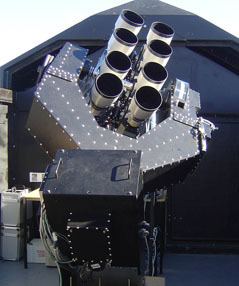Abbreviation WASP | Membership Eight universities | |
 | ||
Purpose Search for distant planets Region served La Palma and Sutherland Website wasp-planets.net
www.superwasp.org | ||
WASP or Wide Angle Search for Planets is an international consortium of several academic organisation performing an ultra-wide angle search for exoplanets using transit photometry. The array of robotic telescopes aims to survey the entire sky, simultaneously monitoring many thousands of stars at an apparent visual magnitude from about 7 to 13.
Contents
SuperWASP is the detection program composed of the Isaac Newton Group, IAC and six universities from the United Kingdom. The two continuously operating, robotic observatories cover the Northern and Southern Hemisphere, respectively. SuperWASP-North is located at Roque de los Muchachos Observatory on the island of La Palma in the Canary Island, Spain, while SuperWASP-South is located at the site of the South African Astronomical Observatory, near Sutherland, South Africa. Both observatories use eight wide-angle cameras that simultaneously monitor the sky for planetary transit events and allow the monitoring of millions of stars simultaneously, enabling the detection of rare transit events.
Instruments used for follow-up characterization employing doppler spectroscopy to determine the exoplanet's mass include the HARPS spectrograph of ESO's 3.6-metre telescope as well as the Swiss Euler Telescope, both located at La Silla Observatory, Chile. WASP's design has also been adopted by the Next-Generation Transit Survey. As of 2016, the Extrasolar Planets Encyclopaedia data base contains a total of 2,107 extrasolar planets of which 118 were discoveries by WASP.
Equipment
WASP consists of two robotic observatories; SuperWASP-North at Roque de los Muchachos Observatory on the island of La Palma in the Canaries and WASP-South at the South African Astronomical Observatory, South Africa. Each observatory consists of an array of eight Canon 200 mm f1.8 lenses backed by high quality 2048 x 2048 science grade CCDs, the model used is the iKon-L manufactured by Andor Technology. The telescopes are mounted on an equatorial telescope mount built by Optical Mechanics, Inc. The large field of view of the Canon lenses gives each observatory a massive sky coverage of 490 square degrees per pointing.
Function
The observatories continuously monitor the sky, taking a set of images approximately once per minute, gathering up to 100 gigabytes of data per night. By using the transit method, data collected from WASP can be used to measure the brightness of each star in each image, and small dips in brightness caused by large planets passing in front of their parent stars can be searched for.
One of the main purpose of WASP was to revolutionize the understanding of planet formation, paving the way for future space missions searching for 'Earth'-like worlds.
Structure
WASP is operated by a consortium of academic institutions which include:
On 26 September 2006, the team reported the discovery of two extrasolar planets: WASP-1b (orbiting 6 million km from star once every 2.5 days) and WASP-2b (orbiting 4.5 million km from star once every 2 days).
On 31 October 2007, the team reported the discovery of three extrasolar planets: WASP-3b, WASP-4b and WASP-5b. All three planets are similar to Jovian mass and are so close to their respective stars that their orbital periods are all less than two days. These are among the shortest orbital periods discovered. The surface temperatures of the planets should be more than 2000 degrees Celsius, owing to their short distances from their respective stars. The WASP-4b and WASP-5b planets are the first planets discovered by the WASP project's cameras in South Africa, while WASP-3b is the third planet discovered by the WASP project's cameras in La Palma.
In August 2009, the discovery of WASP-17b was announced, believed to be the first planet ever discovered to orbit in the opposite direction to the spin of its star, WASP-17.
